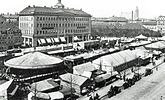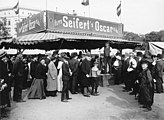Small Leipzig Fair
The Leipziger Kleinmesse is a folk festival-like event in Leipzig . Waiting for the fairground Cottaweg vehicle and run businesses , loose and shooting galleries , other attractions and culinary delights for the guests. The small fair takes place three times a year for a period of about one month: as a small spring fair (April / May), a small summer fair (July / August) and a small autumn fair (September / October). The event is organized by the Leipziger Schaustellerverein e. V.
history
The Leipziger Kleinmesse can look back on a long tradition that is closely linked to the history of the Leipziger Messe . Since time immemorial, jugglers , showmen and other " traveling people " have come to the city at the time of the Leipzig Trade Fair to entertain citizens and trade fair visitors. The city council made it important that everyone moved on after the end of the fair.
With the growth of the Leipziger Messe, the importance of the parallel offers for the “little people” also increased. The small fair established itself, which in addition to amusements of various kinds also had stalls for everyday goods. It also drew the population of the surrounding area to the city for entertainment and shopping. The small fair took place in the squares surrounding the city center such as Augustusplatz , Roßplatz , Königsplatz and Fleischerplatz. Because of the increasing traffic, restrictions on these places had to be accepted at the beginning of the 20th century.
In February 1905 the city council decided to move the small fair outside of the inner city. For this purpose, the so-called Messplatz was built on the Ranstädter cattle pasture in front of the Frankfurter Tor, the end of the development on Frankfurter Strasse. The area of 10.5 hectares was created by filling the ground. Two gatehouses were built at the entrance and, as further entrances, bridges led over the old course of the Elster river on Sedanstraße (today Feuerbachstraße), Fregestraße and Auenstraße (today Hinrichsenstraße). The area offered space for around 1200 stalls and tents. Special attractions at the opening in 1907 included a mountain railway, several hippodromes, an automobile carousel, a bicycle track, athlete and dog theater and a diving ship. The legendary Seifert's Oscar (1861–1932) stood out among the hawkers , later also with his carousel “Seifert's Oscars Magnificent Auto Corso”. Sometimes over 100,000 people visited the new small fair.
During the First World War , showmen showed what was going on and war films were shown in cinemas on the square. From 1928 the city administration began to plan to create a park and sports field on the Messplatz and the Frankfurt Meadows. In 1935, the National Socialists built a parade ground instead. The small fair was relocated to the area on Cottaweg in Lindenau , which is still in use today , where the Kuhburg water , a branch of the Kleiner Luppe , had been backfilled a few years earlier . The exhibition grounds were initially next to and behind the “Lindenauer Zement” cycling track, which was demolished in 1938/1939. At the Easter fair in 1936, operations started with 120 showmen and 700 stalls as well as permanent buildings such as the harbor tavern and Kochs Tanzpalast.
No small fair was held during the Second World War . There was a barrack camp for slave labor on the site . After the square had been cleared, the first Leipzig post-war small fair took place on April 18, 1946, with the attractions “nipple pin”, bumper cars, “waltz ride to the moon”, “caterpillar” and ghost trains. From the 1950s, the state-owned trade with market stalls also took part. In 1957, a large part of the space had to be given to VEB Kraftverkehr. The popularity remained unbroken. In 1978, 600,000 people visited the small exhibition center.
In 1990 the Leipziger Schaustellerverein e. V. founded. As the current organizer, he introduced a third small trade fair season, the small winter trade fair, in November from 1992. However, this took place for the last time in 2009.
literature
Horst Riedel, Thomas Nabert (ed.): Stadtlexikon Leipzig from A to Z . 1st edition. Pro Leipzig, Leipzig 2005, ISBN 3-936508-03-8 , pp. 207/208 .
Web links
Individual evidence
- ↑ Leipzig Small Fair. In: Website of the Schaustellerverein Leipzig e. V. Accessed February 6, 2017 .
- ^ Peter Schwarz: The millennial Leipzig. From the beginning to the end of the 18th century . 1st edition. tape 1 . Pro Leipzig, Leipzig 2014, ISBN 978-3-945027-04-2 , pp. 262/263 .
- ^ A b Peter Schwarz: The millennial Leipzig . From the end of the 18th to the beginning of the 20th century. 1st edition. tape 2 . Pro Leipzig, Leipzig 2014, ISBN 978-3-945027-05-9 , pp. 586-588 .
- ^ Peter Schwarz: The millennial Leipzig . From the beginning of the 20th century to the present. 1st edition. tape 3 . Pro Leipzig, Leipzig 2015, ISBN 978-3-945027-13-4 , pp. 157 .
- ^ Peter Schwarz: The millennial Leipzig . From the beginning of the 20th century to the present. 1st edition. tape 3 . Pro Leipzig, Leipzig 2015, ISBN 978-3-945027-13-4 , pp. 319 .
Coordinates: 51 ° 20 ′ 26 " N , 12 ° 20 ′ 35" E






